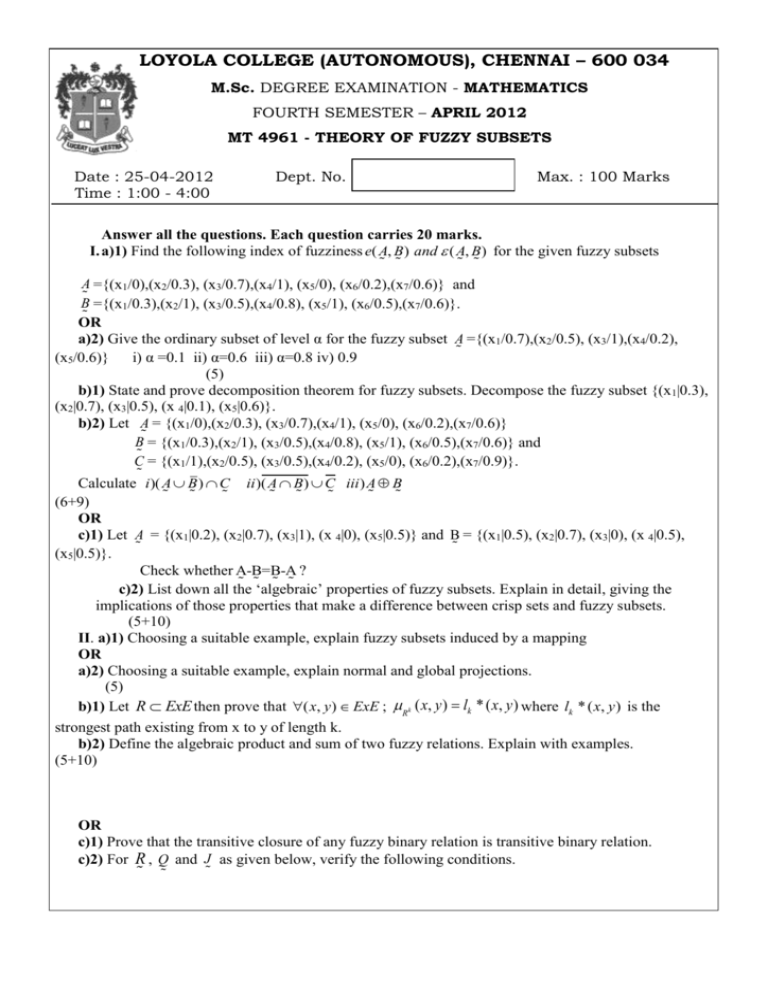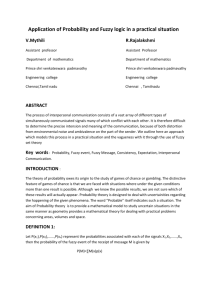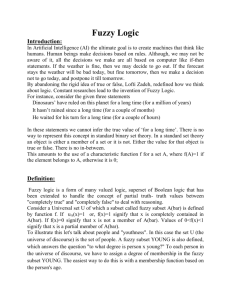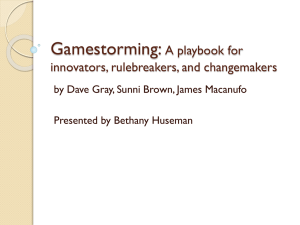mt 4961 - theory of fuzzy subsets
advertisement

LOYOLA COLLEGE (AUTONOMOUS), CHENNAI – 600 034
M.Sc. DEGREE EXAMINATION - MATHEMATICS
FOURTH SEMESTER – APRIL 2012
MT 4961 - THEORY OF FUZZY SUBSETS
Date : 25-04-2012
Time : 1:00 - 4:00
Dept. No.
Max. : 100 Marks
Answer all the questions. Each question carries 20 marks.
I. a)1) Find the following index of fuzziness e( A, B) and ( A, B) for the given fuzzy subsets
A ={(x1/0),(x2/0.3), (x3/0.7),(x4/1), (x5/0), (x6/0.2),(x7/0.6)} and
B ={(x1/0.3),(x2/1), (x3/0.5),(x4/0.8), (x5/1), (x6/0.5),(x7/0.6)}.
OR
a)2) Give the ordinary subset of level α for the fuzzy subset A ={(x1/0.7),(x2/0.5), (x3/1),(x4/0.2),
(x5/0.6)}
i) α =0.1 ii) α=0.6 iii) α=0.8 iv) 0.9
(5)
b)1) State and prove decomposition theorem for fuzzy subsets. Decompose the fuzzy subset {(x1|0.3),
(x2|0.7), (x3|0.5), (x 4|0.1), (x5|0.6)}.
b)2) Let A = {(x1/0),(x2/0.3), (x3/0.7),(x4/1), (x5/0), (x6/0.2),(x7/0.6)}
B = {(x1/0.3),(x2/1), (x3/0.5),(x4/0.8), (x5/1), (x6/0.5),(x7/0.6)} and
C = {(x1/1),(x2/0.5), (x3/0.5),(x4/0.2), (x5/0), (x6/0.2),(x7/0.9)}.
Calculate i )( A B ) C ii )( A B) C iii ) A B
(6+9)
OR
c)1) Let A = {(x1|0.2), (x2|0.7), (x3|1), (x 4|0), (x5|0.5)} and B = {(x1|0.5), (x2|0.7), (x3|0), (x 4|0.5),
(x5|0.5)}.
Check whether A-B=B-A ?
c)2) List down all the ‘algebraic’ properties of fuzzy subsets. Explain in detail, giving the
implications of those properties that make a difference between crisp sets and fuzzy subsets.
(5+10)
II. a)1) Choosing a suitable example, explain fuzzy subsets induced by a mapping
OR
a)2) Choosing a suitable example, explain normal and global projections.
(5)
b)1) Let R ExE then prove that ( x, y ) ExE ; Rk ( x, y ) lk * ( x, y ) where lk * ( x, y ) is the
strongest path existing from x to y of length k.
b)2) Define the algebraic product and sum of two fuzzy relations. Explain with examples.
(5+10)
OR
c)1) Prove that the transitive closure of any fuzzy binary relation is transitive binary relation.
c)2) For R , Q and J as given below, verify the following conditions.
i) R (Q J ) ( R Q) ( R J ) and ii) R(Q J ) ( RQ) ( RJ )
(5+10)
R A B C
1
D
E
J
A
B
C
D
E
Q
A
B
C
D
E
1
1
A
1
0
0
1
0
A
0
0
1
0
0
0
B
0
1
0
0
0
0
0
0
1
1
0
0
.3
B 0
0
.3 .2
C 1
0
0
0
0
0
D
0
0
1
.8 .2
.4
E 0
0
1
0
0
.5 .1
.4 .4
0
1
B
0
C
0
D
0
0 0
0
.9 .7 .3
0 0
0
.7 .3
0 0
0
.3
0 0
0
A
.5
0
.5
.7
.7
0
.7
C
.5
.8
0
.7
0
D
0
0
E
1
.3
E
.5
.1
0
1
1
0
.2
.3
0
0
.5
0
0
0
III.
a)1) Contrast fuzzy ordinal relation with fuzzy resemblance relation. Give
an example.
OR
a)2) Consider the relation R given with the membership function
R ( x, y)
1
, for all x, y N
1 x y
Is this relation a resemblance relation?
(5)
b)1) Define anti symmetric and perfect anti symmetric fuzzy binary relations. Give examples. Is it true to
say that any perfect anti symmetric relation is evidently anti symmetric?
b)2) Let R E E be a similitude relation. Let x, y, z be the elements of E. Put
a R ( x, y ) R ( y, x); b R ( y, z ) R ( z, y); c R ( z, x) R ( x, z );
then prove
that c a b or a b c or b c a.
(7+8)
OR
b)3) Explain the following in detail with examples: Relation of (i)preorder (ii) anti reflexive
preorder (iii) similitude (iv)dissimilitude and (v)Resemblance.
(15)
IV.
a)1) Explain the three fundamental problems in the process of pattern recognition.
OR
a)2) State the fuzzy c-means algorithm as given J. Bezdek.
(5)
b)1) How will you justify that fuzzy applications will yield better results in the field of pattern recognition
rather than any other traditional methods.
b)2) Explain how fuzzy clustering methods are based on fuzzy equivalence relation. Given any
relation, how is it possible to apply this method.
(7+8)
OR
c)1) Explain in detail with examples (i)the two fuzzy clustering methods and (ii) the two pattern recognition
methods.
(15)
V. a) Explain how fuzzy application could make a difference in the field of Economics OR Engineering.
(5)
b) Explain in detail, with a suitable example, fuzzy application in the field of Medicine OR Robotics.
(15)
******






